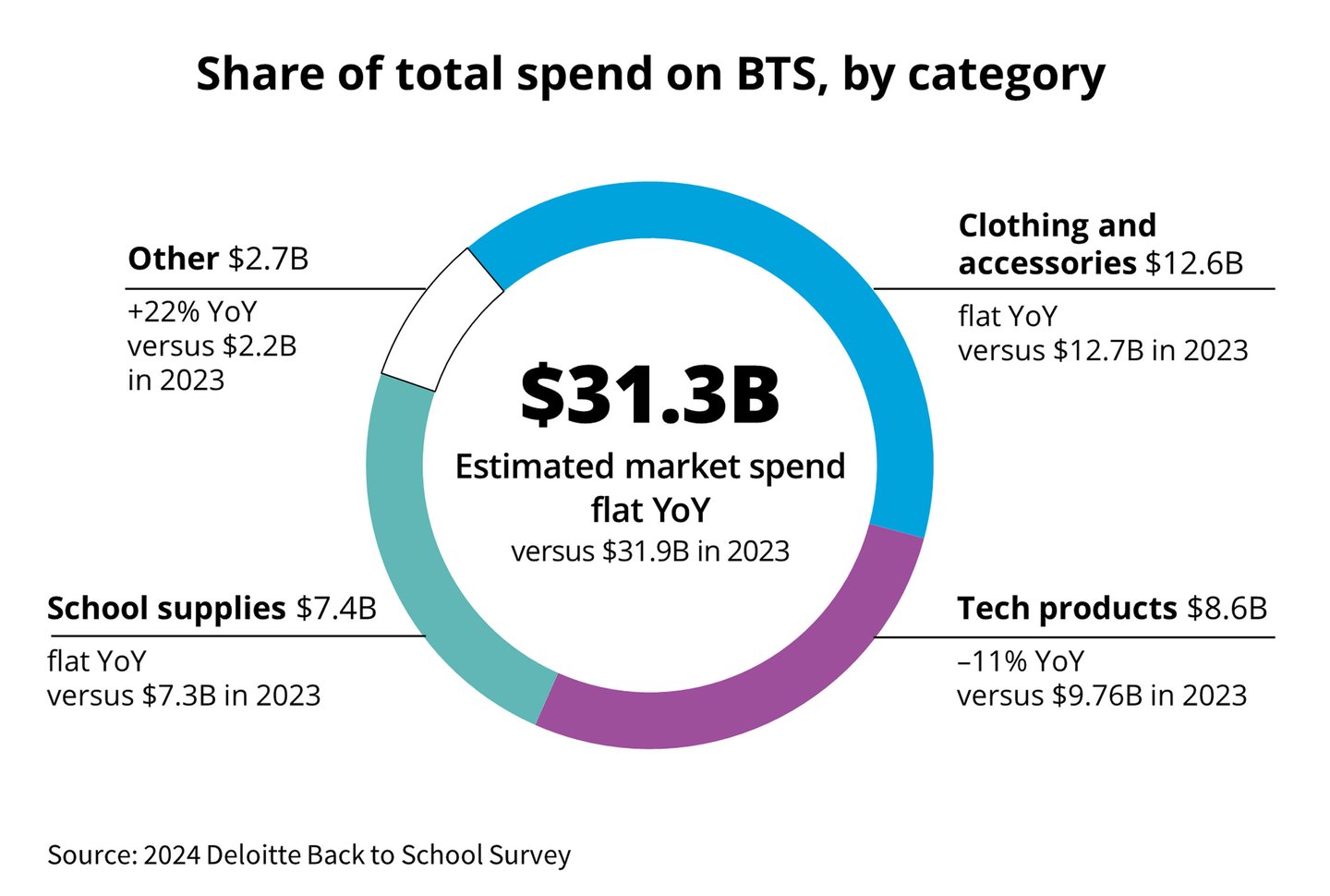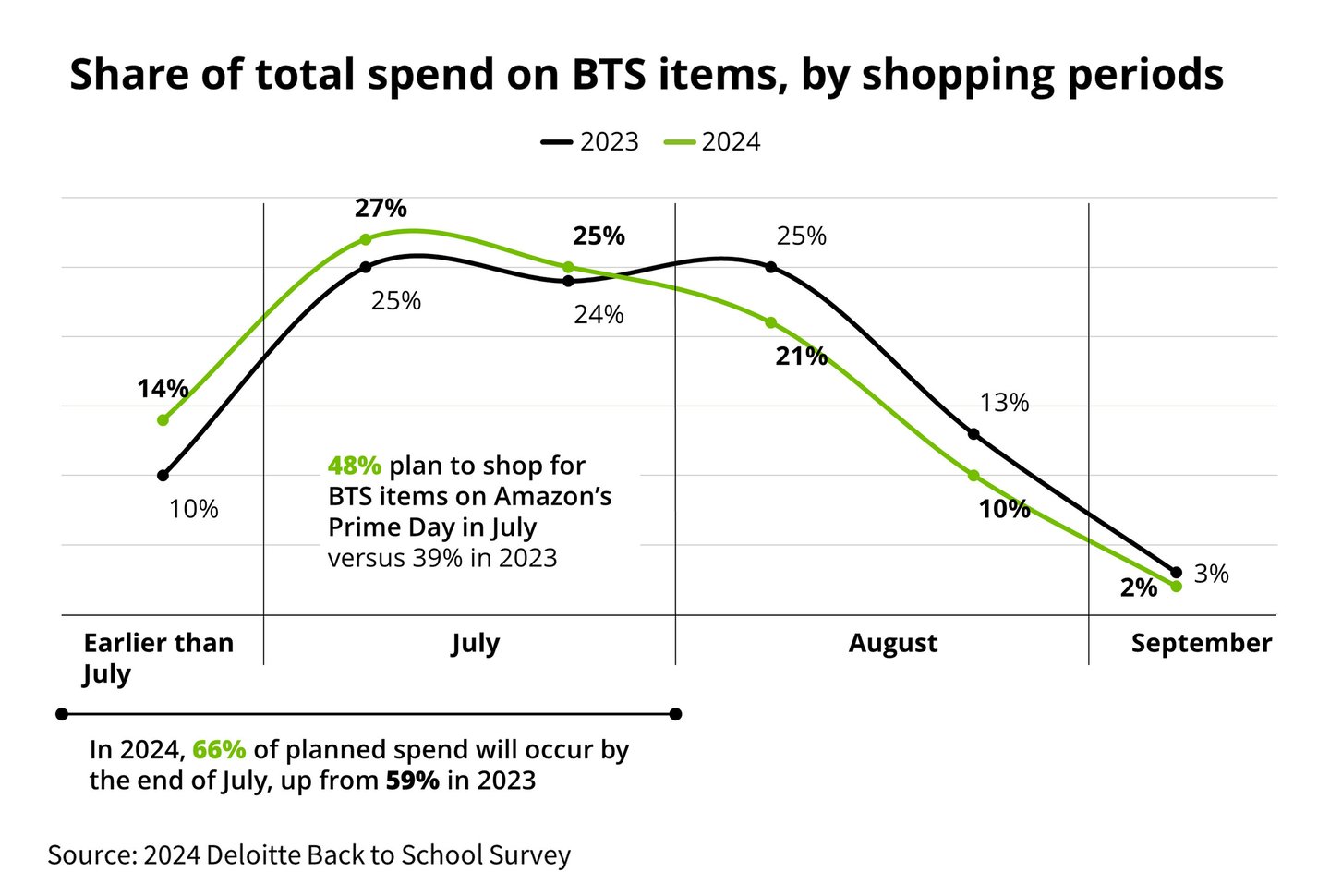Research: Financial Concerns Sway Back-to-School Spending
Deloitte conducted a back-to-school (BTS) survey of parents with at least one child attending school in grades K-12 this fall, from May 22-30.
Key Takeaways:
- BTS spending for K-12 students will likely remain flat and is estimated to reach a collective $31.3 billion, or approximately $586 per student.
- Parents plan to decrease their spending on technology products by 11% year-over-year and increase spend on other categories, such as personal hygiene and educational furniture, by 22%. Spending on clothing and school supplies remains unchanged.
- Shoppers prioritize retailers offering value and convenience as mass merchants (77%) and online retailers (65%) are top destinations.
- In search of deals, parents plan to shop across 4.7 retail formats on average, up from 3.9 in 2023, and may sacrifice loyalty to stay within budget.
- Despite financial concerns, 85% of surveyed parents would splurge on their child's must-have BTS products, and 50% would shop for themselves.
- 86% of parents enrolled their children in extracurricular activities and plan to spend an additional $582, including fees and equipment.
- While more parents say their children use generative artificial intelligence (GenAI) for their schoolwork than last year (23% versus 15% in 2023), they are divided on its benefits.
A closer look at the survey
According to the Bureau of Labor Statistics' Consumer Price Index, the cost of school supplies has increased 24.5% over the past four years. Additionally, Deloitte's ConsumerSignals research found that 73% of consumers are concerned about rising prices for everyday purchases.
As the season moves earlier into July, parents look for early savings to enable their spending on indulgences and extracurricular activities, Deloitte inferred in a statement on its BTS survey results.
Financial concerns impact spending priorities
Ongoing inflationary concerns and a “cost-of-living squeeze” is expected to keep spending steady from last year. Parents surveyed expect to spend $586 per student in grades K-12, down just $11 YOY (up $57 compared to 2020).
- Clothing and school supplies are expected to account for most of the BTS market spending, remaining flat at $12.6 billion and $7.4 billion, respectively.
- BTS spending strategies include cutting back on other expenses across all income levels (64% of low-income earners, 57% of middle-income earners, and 39% of high-income earners) or delaying major household purchases (52% of low-income earners, 45% of middle-income earners, and 35% of high-income earners).
- Despite keeping an eye on their budget, 85% of parents can be influenced by their children to splurge on must-have products and brands. Moreover, half of parents plan to shop for themselves during the season.
"We expect back-to-school spending to be flat to down modestly when adjusted for inflation, mainly driven by middle-income families juggling financial priorities and ongoing inflation perceptions,” Stephen Rogers, managing director, Deloitte Insights Consumer Industry Center, Deloitte Services LP, said in the statement. “Retailers can expect headwinds to volume and loyalty as consumers seek to save money. However, wanting to please their kids, retailers will likely have opportunities to harness the indulgences parents are willing to make."
Value top of mind for parents
Parents surveyed are prioritizing value over brand and retailer loyalty to find the best deals, visiting more retail formats and shopping earlier in the summer.
More parents plan to make the most of early discounts, with 66% of spending expected to occur by the end of July, up from 59% in 2023. Moreover, 59% believe the best deals occur earlier in the season, compared to 41% who think they appear later.
- 62% of parents surveyed plan to shop within a fixed budget and may sacrifice loyalty to do so:
- 67% will shift brands if the preferred is too expensive.
- 62% will shop at a more affordable retailer.
- 50% will shop for private labels over name brands.
- 7-in-10 surveyed parents seek convenience (convenient locations, delivery options, and easy returns) — making it the No. 1 driver for where they plan to spend the most.
- Multi-channel retailers account for 80% of the total BTS intended spend, up from 73% last year, and 70% of families plan to shop in-store and online, up from 66%.
- More families plan to purchase used items to maximize value further: 4-in-10 (across income groups) expect to buy a used or refurbished item this season. Technology and apparel lead the charge among pre-owned products (both at 28%).
Social commerce patterns emerge
Technology continues to help families further economize by providing opportunities for product reviews and promotions, Deloitte said.
- Social commerce is on the rise among K-12 parents, with 1-in-3 surveyed planning to use social media sites to assist in their BTS shopping. In addition, 1-in-8 plan to make a purchase on social media.
- GenAI is nascent for BTS shopping, with 18% of parents planning to use the technology when purchasing.
"Families are searching for deals and prioritizing value and convenience to save wherever possible,” added Brian McCarthy, principal, Retail Strategy, Deloitte Consulting. “This dynamic creates an opportunity for retailers to take some of the anxiety out of the season by extending loyalty programs and incentives. In addition, building a seamless omnichannel approach could better position retailers to see consumers coming back throughout the season."
Survey Methodology
Deloitte's "2024 Deloitte Back-to-School Survey," was conducted online using an independent research panel between May 22 and May 30, 2024. It surveyed 1,198 parents with at least one child attending school in grades K-12 this fall.








